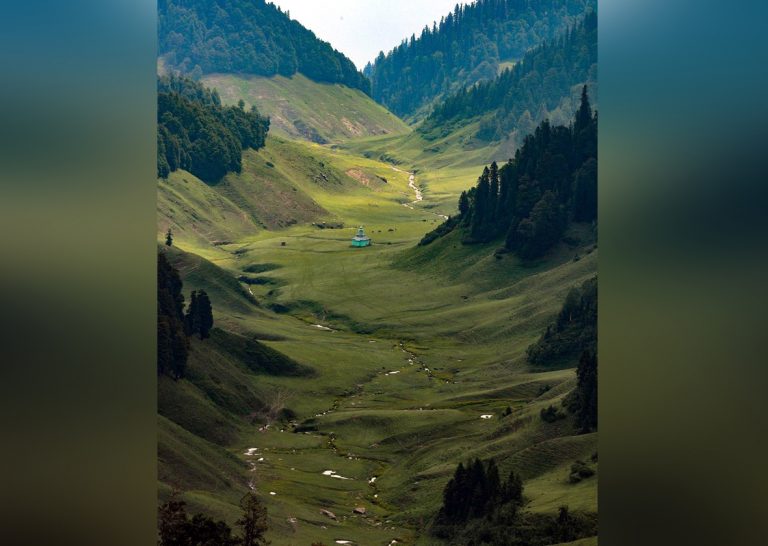By: Sadaket Malik
Lamhote Meadows in Doda’sBhalessa (Chilly Pingal) is a place of natural beauty and cultural significance.Situated in Jammu and Kashmir, Lamhote is not merely a scenic landscape but a reservoir of traditions and livelihoods for the local communities, particularly the Paharis, ethnic Kashmiri, Gujjars, and Bakerwals. The frequent visits by these communities, primarily for cattle grazing activities, underscore the intrinsic connection they share with Lamhote. However, lack of a proper road leading to this enchanting meadow poses challenges for both the local residents and the untapped tourism potential of the region.
The enchanting view of Lamhotemeadows in Bhalessa, Jammu and Kashmir, captivates the beholder with its mesmerizing beauty. The confluence of coniferous forests, sprawling meadows, and majestic snow-capped mountains explore the natural wonders. As the sunlight dances on the landscape, casting a golden hue on the grassy expanses, Lamhote unfolds like a picturesque painting, inviting all who gaze upon it into a realm of serene enchantment. The scenery, with its harmonious blend of colors and textures, evokes a sense of tranquility and awe, making Lamhote Meadows a truly enchanting destination for those seeking respite in the embrace of nature’s wonders.
For the Paharis, ethnic Kashmiri, Gujjars, and Bakerwals, the vast expanse of the place provides immensely rich grounds for cattle grazing, a crucial aspect of their traditional livelihoods. Moreover, Lamhote holds cultural significance, often serving as a dhok—a traditional resting place for these communities during their seasonal migrations. Preserving these cultural ties is essential for the identity and heritage of the local populace.
The villages nearby in Tehsil Chilly Pingal offer a glimpse into traditional lifestyles that have stood the test of time. From agricultural practices to folk arts and crafts, the residents carry forward age-old traditions, creating a living museum of ethnic heritage. Paharies, Gujjars and Bakerwals are the ethnic people who inhibit the place.
Ethnic relevance is especially evident during cultural festivals and celebrations that take place in these villages. These events showcase traditional dances, music, and rituals that have been passed down through generations, providing a deeper understanding of the local way of life.
The absence of a proper road to Lamhote poses logistical challenges for the local communities and limits the potential for broader economic activities. Constructing a road is imperative not only for the convenience of the local residents but also as a strategic move to unlock the tourism potential that Lamhote inherently possesses.
Lamhote’s natural charm, with its coniferous forests, meandering streams, and snow-capped mountains, is a treasure waiting to be explored. Constructing a road becomes the gateway to unlocking this tourism potential. Tourists, drawn to the pristine beauty and cultural richness of Lamhote, can contribute significantly to the local economy. This influx of visitors presents opportunities for various tourism-related activities, including homestays, guided tours, and artisanal experiences, providing an economic boost to the region.
The development of the place as a tourist destination not only brings economic opportunities but also serves as a catalyst for overall progress in the region. Local businesses, such as small-scale accommodations, eateries, and handicraft enterprises, can thrive with the increased footfall. Additionally, employment opportunities generated by the burgeoning tourism sector contribute to the economic empowerment of the local population.
Recognizing Lamhote as a popular site, the Tourism Department of Jammu and Kashmir can play a pivotal role in the identification and development of this unique destination. Strategic investments in infrastructure, sustainable tourism practices, and community involvement can transform Lamhote into a flagship destination. The department’s engagement is crucial not only for promoting tourism but also for preserving the cultural integrity of the region, ensuring that the allure remains authentic and untarnished.
In short we can say that construction of a road to Lamhote Meadows is not just a matter of infrastructure development but a strategic initiative with far-reaching implications. It goes beyond facilitating travel; it is a pathway to economic progress, cultural preservation, and the unlocking of a hidden site. It has the potential to emerge not only as a tourist destination but as a evidence to the harmonious coexistence of nature, culture, and economic prosperity.




